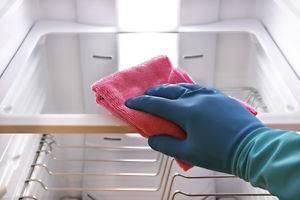When You Find a Fuzzy Blob in Your Refrigerator, It Is Time to Clean
TEXARKANA, Ark. –
What is that fuzzy blob growing in your refrigerator? What was once a food item now appears to be someone’s science experiment. It has become unrecognizable and you wonder what it is, or what you need to do with it.
When mold is found on food, you see only the tip of the iceberg. The poisons mold can form under the surface of the food. They are a group of organisms invisible to the naked eye. Only after they grow into colonies of large numbers of organisms do we see them as fuzz on our food.
Mold requires very little moisture or air to grow, so they can thrive almost anywhere. They can grow at both room temperature and in the refrigerator. They are also tolerant of high levels of salt and sugar, so they can be found on bacon, cured ham, jams and jellies.
Under specific circumstances you may be able to save a food which contains mold. Not
all foods can be saved and many need to be discarded.
In the case of dairy products, you can cut off mold found on hard cheeses. Cut off
at least an inch around and below the mold spot. Be careful not to cut into the mold
itself. Wrap the cheese in fresh plastic wrap or ziptop bag for additional storage.
Mold on soft cheeses, cottage cheese, yogurt, sour cream and individual cheese slices
should be thrown away.
Hard salami and dry-cured country ham with a small amount of mold can be treated in the same manner as hard cheese. Less firm meat products need to be discarded. These include bacon, hot dogs, sliced luncheon meats, meat pies or canned ham.
Small spots of mold can be cut away from the surface of hard vegetables like cabbage, and carrots, but soft fruits and vegetables that have molded should be discarded.
If you find that some of your jams and jellies have mold, discard those. Although it may be possible to remove enough of the sweet spread with mold to reduce the hazards, it is difficult to assure that enough is removed for safety. For this reason, the best idea is to throw away any sweet spreads that have developed mold.
As a general rule of thumb, any other products should be discarded if moldy. These include bread, cake, buns, corn-on the cob, nuts, flour, whole grains, rice, dried beans and peas and peanut butter. Pay special attention to processed foods with preservatives. These are at a high risk for mold growth and should be discarded.
When removing moldy food from the refrigerator, wrap the molded food in plastic wrap or place in a small paper bag before putting it into the trash can. This prevents contamination of the rest of the room. Remember mold is a living organism.
Once food with mold has been found, thoroughly clean the interior of the refrigerator, especially where the moldy foods were found. Clean the surface thoroughly with hot, soapy water and rinse. Remove any racks and bins, and repeat the procedure.
While cleaning the inside of your refrigerator, remember the outside as well. Wash it down with hot, soapy water and rinse as you did the inside. Go a step further and vacuum the coils at the back of your refrigerator unit. Built up dust robs a coil of its ability to dissipate heat and makes the compressor work harder, which shortens the compressor’s life.
For more information, contact the Miller County Extension Office, 870-779-3609 or visit us in room 215 at the Miller County Courthouse. We're online at chadley@uada.edu, on Facebook at UAEXMillerCountyFCS/CarlaHaleyHadley, on Twitter @MillerCountyFCS or on the web at uaex.uada.edu/Miller.
By Carla Haley-Hadley
County Extension Agent - FCS
The Cooperative Extension Service
U of A System Division of Agriculture
Media Contact: Carla Haley-Hadley
County Extension Agent - FCS
U of A Division of Agriculture
Cooperative Extension Service
400 Laurel Street, Suite 215 Texarkana AR 71854
(870) 779-3609
chaley@uada.edu
Related Links
The Arkansas Cooperative Extension Service is an equal opportunity institution. If
you require a reasonable accommodation to participate or need materials in another
format, please contact your County Extension office (or other appropriate office)
as soon as possible. Dial 711 for Arkansas Relay.
Pursuant to 7 CFR § 15.3, the University of Arkansas System Division of Agriculture
offers all its Extension and Research programs and services (including employment)
without regard to race, color, sex, national origin, religion, age, disability, marital
or veteran status, genetic information, sexual preference, pregnancy or any other
legally protected status, and is an equal opportunity institution.
